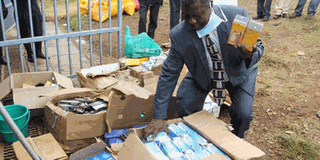Illicit trade may slow industrial revolution

Barnabas Lihema, Kenya Bureau of Standards North Rift Manager displays counterfeit geometrical sets and ball point pens. PHOTO | FILE | NATION MEDIA GROUP
What you need to know:
Kenya seeks to transform the manufacturing sector from the 8.4 per cent share of the country’s wealth to 15 per cent in the medium term.
- Illicit goods and services remain the biggest impediment for Kenya’s realisation of a healthy nation.
Kenya’s development objective is to transition to a higher middle-income economy of $.4,036 per capita from the current lower-income status of $1,245.
Such a shift to that level of economic development will require more additional investments in manufacturing, improved healthcare, affordable decent housing and increased food security — which form the core of President Uhuru Kenyatta’s economic blue print, the ‘Big Four’ agenda.
Kenya seeks to transform the manufacturing sector from the 8.4 per cent share of the country’s wealth to 15 per cent in the medium term.
To achieve this, we would be required to spur manufacturing output by an additional Sh1.6 trillion from last year’s Sh648 billion.
EXPORTS DEVELOPMENT
The 2018 Trade Week and Exposition saw the launch of an aggressive integrated exports development and promotion strategy that seeks to grow exports by 25 per cent annually to achieve a trade surplus. One of the most ambitious policy frameworks since Independence, it will see mobilisation of more than Sh800 billion from trade, industry, agriculture, fish, livestock, mining, petroleum, handcrafts and services economic sectors.
Indeed, Kenya is set for economic transformation, where it is expected that the wellbeing of Kenyans will be improved in line with Vision 2030, which postulates a high quality of life.
A surge in illicit trade, however, may turn out to be the biggest deterrent in the realisation of the Big Four. Illicit goods and services remain the biggest impediment for Kenya’s realisation of a healthy nation, one that accords decent and affordable housing to its citizenry and is food-secure.
CURB THE MENACE
Illicit trade has driven manufacturing industries out of business, creating joblessness, and caused terminal illnesses and deaths, in addition to loss of wealth, in part through low tax revenues, collapse of buildings and low agricultural productivity.
The forms of illicit trade that inhibit our path to industrial revolution include counterfeiting, tax evasion, sale of prohibited goods and dumping.
The government’s deliberate move to curb the menace should be welcomed.
Recommendations during this year’s trade expo include strengthened trade support institutions, improved border controls, awareness creation, public alerts on illicit goods, genuine trade promotion in and out of the country, and formation of a trade remedies agency, which is under way.
CREATING AWARENESS
During the trade week, both licit and illicit products were showcased as part of creating awareness.
This will enhance the consumption of genuine products, including the ‘Made in Kenya’ brands, locally and internationally.
That way, our exporting companies will gain a local, regional and global market presence and recognition.
County and national trade fairs and exhibitions will be held during the year to sensitise Kenyans on both the licit and illicit products as part of escalation of the fight
against illicit trade. Kenyans are called upon to seize the moment and support the fight against illicit trade to safeguard the country’s much-needed progress envisaged in the Big 4 agenda.
Mr Biwott is the CEO Export Promotion Council. [email protected].





